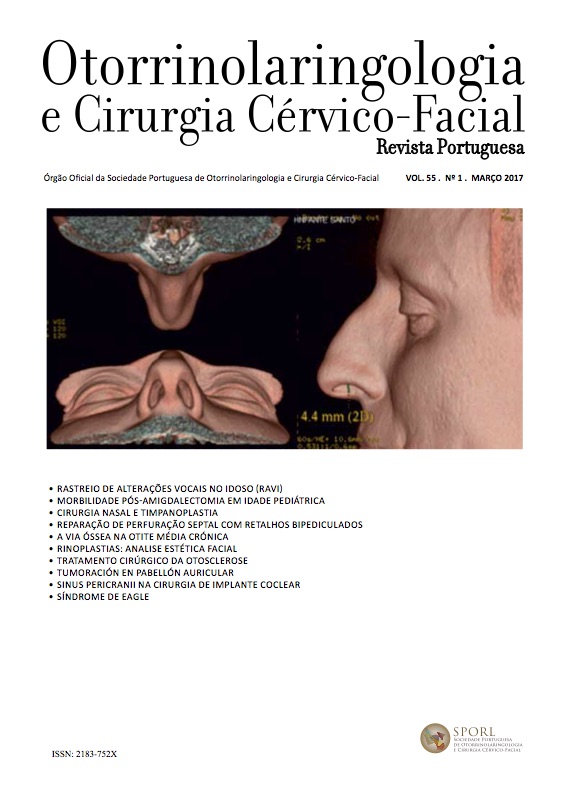Eagle Syndrome - Case report and literature review
DOI:
https://doi.org/10.34631/sporl.666Keywords:
Síndrome de Eagle, síndrome estiloideu, apófise estiloideiaAbstract
.Downloads
References
Revilla Borjas C, Stuyt MT (1989) El sindrome estiloideo: a proposito de 3 casos. Annales de Otorrinolaringologia Iberoamericana 659–666
Winkler S, Sammartino F: Stylohyoid syndrome: report of a case. Oral Surg Oral Med Oral Pathol 51(2): 215e217, 1981
Babad MS (1995) Eagle’s syndrome caused by traumatic fracture of a mineralized stylohyoid ligament—literature review and a case report. Cranio 13:188–192
Camarda AJ, Deschamps C, Forest D: I. Stylohyoid chain ossification: a discussion of etiology. Oral Surg Oral Med Oral Pathol 1989; 67:508-514.
Yavuz H, Caylakli F, Yildirim T, Ozluoglu LN: Angulation of the styloid process in Eagle’s syndrome. Eur Arch Otorhinolaryngol 265(11): 1393e1396, 2008
Farhat HI, Elhammady MS, Ziayee H, Aziz-Sultan MA, Heros RC: Eagle syndrome as a cause of transient ischemic attacks. J Neurosurg 110(1): 90e93, 2009
Cano LM, Cardona P, Rubio F: Eagle syndrome and carotid dissection. Neurologia 2010; 25:266-267.
Bozkir MG, Boga H, Dere F (1999) The evaluation of elongated styloid process in panoramic radiographs in edentulous patients. Tr J Med Sci 29:481–485
Hwang JY, Hwang EH, Lee SR (2005) A study on the styloid process in panoramic radiographs. Korean J Oral Maxillofac Radiol 35:105–110
Kaufman SM, Elzay RP, Irish EF (1970) Styloid process variation. Radiologic and clinical study. Arch Otolaryngol 91:460–463
Lengele BG, Dhem AJ (1988) Length of the styloid process of the temporal bone. Arch Otolaryngol Head Neck Surg 114:1003–1006
Masashi Y (2002) Radiographic images of the styloid process. J Osaka Odontol Soc 65:165–180
Scaf G, Freitas DQ, Loffredo LC (2003) Diagnostic reproduc-ibility of the elongated styloid process. J Appl Oral Sci 11:120–124
Sokler K, Sandev S (2001) New classification of the styloid process length—clinical application on the biological base. Coll Antropol 25:627–632
Keur JJ, Campbell JP, McCarthy JF, Ralph WJ: The clinical significance of the elongated styloid process. Oral Surg Oral Med Oral Pathol 1986; 61:399-404.
Prasad KC, Kamath MP, Reddy KJM, et al. Elongated styloid process (Eagle’s syndrome): a clinical study. J Oral Maxillofac Surg 2002;60: 171–5.
Eagle WW: Elongated styloid process; symptoms and treatment. AMA Arch Otolaryngol 1958; 67:172-176.
Miller DB: Eagle’s syndrome and the trauma patient. Significance of an elongated styloid process and/or ossified stylohyoid ligament. Funct Orthod 1997; 14:30-35.
Murtagh RD, Caracciolo JT, Fernandez G: CT findings associated with Eagle syndrome. Am J Neuroradiol 2001; 22: 1401-1402.
Jan A: Stylohyoid syndrome. J Pak Med Assoc 1989; 39:23.
Woolery WA: The diagnostic challenge of styloid elongation (Eagle syndrome). J Am Osteopath Assoc 1990; 90:88-89.
Shankland WE II: Anterior throat pain syndromes: causes for undiagnosed craniofacial pain. J Craniomandib Pract 2010; 28:50-59.
Buono U, Mangone GM, Michelotti A, et al. Surgical approach to the stylohyoid process in Eagle’s syndrome. J Oral Maxillofac Surg 2005; 63:714–16
Hossein R, Kambiz M, Mohammad D, et al. Complete recovery after an intraoral approach for Eagle syndrome. J Craniofac Surg 2010;21:275–6.
Koivumäki A, Marinescu-Gava M, Järnstedt J, et al. Trauma induced eagle syndrome. Int J Oral Maxillofac Surg 2012;41:350–3.
Wong ML, Rossi MD, Groff W, Castro S, Powell J. Physical therapy management of a patient with Eagle syndrome. Physiother Theory Pract. 2011;27:319–327.
Glogoff MR, Baum SM, Cheifetz I. Diagnosis and treatment of Eagle's syndrome. J Oral Surg. 1981;39:941–944
Min Kyu Han, MD, Do Wan Kim, MD. Non Surgical Treatment of Eagle's Syndrome - A Case Report -Korean J Pain. 2013 Apr; 26(2): 169–172.
Marlon L Wong, PT, DPT, OCS, MTC, Mark D Rossi, PT, PhD, CSCS, Wade Groff, SPT, Sonia Castro, SPT, Jennifer Powell, SPT; Physical therapy management of a patient with Eagle syndrome; Physiotherapy Theory and Practice, 27(4):319–327, 2011






